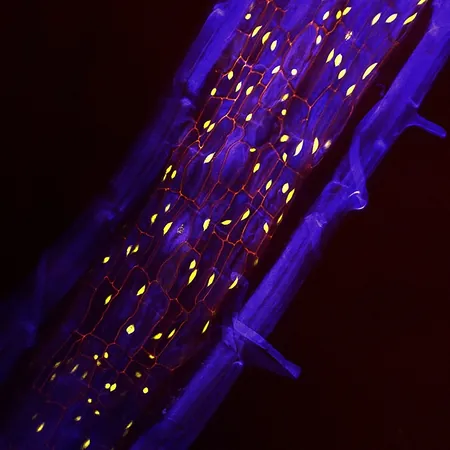
Unlocking Nature’s Armor: How Periderm Protects Plants and Combats Climate Change
2025-01-10
Author: Yu
In a groundbreaking study, researchers have unveiled the vital role of the periderm—the protective layer that acts as an armor for plant roots—revealing its dual functionality in shielding plants from environmental stress and contributing to climate change mitigation.
Despite their stationary existence, plants have developed remarkable strategies to combat the harsh realities of nature. The periderm serves as a fortification against various challenges, including drought, extreme temperatures, and harmful microbial infections, ensuring plant survival in ever-changing climates.
The Science Behind Plant Protection and Climate Solutions
A pioneering study by scientists at the Salk Institute has provided invaluable insights into the periderm's composition and its implications for both plant health and environmental stability. With sophisticated tools like single-nuclei RNA sequencing, the researchers constructed an extensive gene expression atlas focused on Arabidopsis thaliana, a widely studied model organism in plant biology.
Their findings, published in the renowned journal Developmental Cell, spotlighted phellem cells, which are integral to the periderm. These specialized cells are enriched with suberin, a waxy compound that not only bolsters plant defenses but also acts as a natural carbon sink, capturing and storing atmospheric CO2 within the plant's root structure. This function is crucial for enhancing plant resilience and contributing to long-term carbon sequestration in the soil.
A Closer Look at Phellem Development
The research team focused on documenting the multi-stage development of phellem cells, tracing their journey from pericycle cells to mature structures. Key accomplishments included:
Identifying Various Developmental Stages: A detailed examination revealed distinct phases in phellem cell maturation, offering a deep understanding of their lifecycle.
Discerning Regulatory Genes: The discovery of crucial regulatory genes, particularly MYB67, demonstrated a significant role in the maturation and functionality of phellem cells.
MYB67: The Genetic Guardian of Phellem
Investigating the role of MYB67 provided pivotal insights into the genetic pathways that drive phellem development. Harnessing this knowledge could enable scientists to manipulate gene expressions, potentially increasing suberin production in various crops, thus fortifying their defenses against environmental threats.
The Essential Role of Suberin
Suberin is more than just a structural component; it plays a critical role in both plant survival and global environmental health:
Boosting Plant Resilience: By fortifying defenses against root rot and various diseases, suberin significantly enhances the health and productivity of crops.
Carbon Sequestration Capabilities: As a long-term carbon storage medium, suberin’s ability to capture atmospheric CO2 within plant roots can offer a substantial means of addressing climate change through natural processes.
Implications for Agriculture and Climate Action
The implications of these findings extend beyond academia, presenting remarkable opportunities for enhancing agricultural practices and climate change strategies:
Advancing Crop Resilience: Understanding the genetic factors governing phellem development could lead to the engineering of crops that exhibit improved resistance to drought and salinity, directly translating to more robust agricultural systems.
Boosting Carbon Capture: These insights pave the way for developing crops with enhanced suberin production—a sustainable and natural strategy to increase carbon sequestration in agricultural soils, providing a smart approach to climate mitigation.
Looking Ahead: Exploring Future Research Avenues
The Salk researchers are enthusiastic about diving deeper into the roles of the periderm. Future studies will aim to:
Identify Additional Genes: Further exploration into the genetic mechanisms surrounding phellem and suberin production.
Investigate Plant Defense Mechanisms: Understanding how the periderm protects against root diseases and environmental stresses.
Enhance Agricultural Carbon Sequestration: Translating the discoveries about the periderm into practical applications that benefit farming practices and combat global climate change.
This significant research breakthrough ushers in a new era of understanding plant root biology. By leveraging the periderm’s protective and carbon-capturing abilities, scientists are paving new pathways toward more sustainable agricultural practices that can help combat climate change effectively, ensuring a greener future for both plants and the planet.
Stay tuned as the saga of the periderm unfolds, potentially reshaping our approach to agriculture and environmental conservation!





 Brasil (PT)
Brasil (PT)
 Canada (EN)
Canada (EN)
 Chile (ES)
Chile (ES)
 Česko (CS)
Česko (CS)
 대한민국 (KO)
대한민국 (KO)
 España (ES)
España (ES)
 France (FR)
France (FR)
 Hong Kong (EN)
Hong Kong (EN)
 Italia (IT)
Italia (IT)
 日本 (JA)
日本 (JA)
 Magyarország (HU)
Magyarország (HU)
 Norge (NO)
Norge (NO)
 Polska (PL)
Polska (PL)
 Schweiz (DE)
Schweiz (DE)
 Singapore (EN)
Singapore (EN)
 Sverige (SV)
Sverige (SV)
 Suomi (FI)
Suomi (FI)
 Türkiye (TR)
Türkiye (TR)
 الإمارات العربية المتحدة (AR)
الإمارات العربية المتحدة (AR)